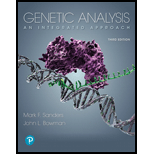
Concept explainers
Some proteins are composed of two or more polypeptides. Suppose the DNA template strand sequence
What is the amino acid sequence of the polypeptideproduced from this sequence?
What term is used to identify a functional protein like this one formed when two identical polypeptides jointogether?
To analyze:
Few proteins are composed of two or more polypeptides. Assume the DNA template strand sequence 3’-TACGTAGGCTAACGGAGTAAGCTAACT-5’ yields a polypeptide that joins in sets to form a functional protein.
From this sequence, the amino acid sequence of the polypeptide produced is to be explained.
Name the term used to identify a functional protein which is produced from the joining of two identical polypeptides.
Introduction:
In molecular biology, the central dogma describes the formation of a polypeptide chain from the template DNA strand through the intermediate formation of mRNA.
Transcription Translation
DNA → mRNA → polypeptide
The DNA contains the information for the given polypeptide in the form of specific sequences of codons. The codon is a triplet of nitrogen bases coding the specific amino acid. There are 64 codons which code 20 different types of amino acids. These amino acids are bounded together by a peptide bond to form polypeptide. The number of polypeptides bounded together form the protein molecule.
Amino acid → polypeptide → Protein molecule
Explanation of Solution
The DNA template will undergo the following process to form the polypeptide chain:
3’ TACGTAGGCTAACGGAGTAAGCTAACT5’ DNA template
↓ Transcription
5’AUGCAUCCGAUUGCCUCAUUCGAUUGA3 mRNA
↓ Translation
N-Met-His-Pro-Ileu-Ala-Ser-Phe-Asp-Stop-C Polypeptide chain
Functional proteins are made up of two or more polypeptide chains which may be same or different to each other. As the two polypeptides chains are identical in nature, they will join together to form a homodimer.
The amino acid sequence of a polypeptide chain is determined by the sequence of codons present on the DNA template strand.
The term “homodimer” is used when two identical polypeptide chains are bounded together.
Want to see more full solutions like this?
Chapter 9 Solutions
Genetic Analysis: An Integrated Approach (3rd Edition)
- can you help? I think its B but not surearrow_forwardSkip to main content close Homework Help is Here – Start Your Trial Now! arrow_forward search SEARCH ASK Human Anatomy & Physiology (11th Edition)BUY Human Anatomy & Physiology (11th Edition) 11th Edition ISBN: 9780134580999 Author: Elaine N. Marieb, Katja N. Hoehn Publisher: PEARSON 1 The Human Body: An Orientation expand_moreChapter 1 : The Human Body: An Orientation Chapter Questions expand_moreSection: Chapter Questions Problem 1RQ: The correct sequence of levels forming the structural hierarchy is A. (a) organ, organ system,... format_list_bulletedProblem 1RQ: The correct sequence of levels forming the structural hierarchy is A. (a) organ, organ system,... See similar textbooks Bartleby Related Questions Icon Related questions Bartleby Expand Icon bartleby Concept explainers bartleby Question Draw a replication bubble with two replication forks.blue lines are DNA single strands and red lines are RNA single strands.indicate all 3' and 5’ ends on all DNA single…arrow_forwardProvide an answerarrow_forward
- Question 4 1 pts Which of the following would be most helpful for demonstrating alternative splicing for a new organism? ○ its proteome and its transcriptome only its transcriptome only its genome its proteome and its genomearrow_forwardIf the metabolic scenario stated with 100 mM of a sucrose solution, how much ATP would be made then during fermentation?arrow_forwardWhat is agricuarrow_forward
- When using the concept of "a calorie in is equal to a calorie out" how important is the quality of the calories?arrow_forwardWhat did the Cre-lox system used in the Kikuchi et al. 2010 heart regeneration experiment allow researchers to investigate? What was the purpose of the cmlc2 promoter? What is CreER and why was it used in this experiment? If constitutively active Cre was driven by the cmlc2 promoter, rather than an inducible CreER system, what color would you expect new cardiomyocytes in the regenerated area to be no matter what? Why?arrow_forwardWhat kind of organ size regulation is occurring when you graft multiple organs into a mouse and the graft weight stays the same?arrow_forward
- What is the concept "calories consumed must equal calories burned" in regrads to nutrition?arrow_forwardYou intend to insert patched dominant negative DNA into the left half of the neural tube of a chick. 1) Which side of the neural tube would you put the positive electrode to ensure that the DNA ends up on the left side? 2) What would be the internal (within the embryo) control for this experiment? 3) How can you be sure that the electroporation method itself is not impacting the embryo? 4) What would you do to ensure that the electroporation is working? How can you tell?arrow_forwardDescribe a method to document the diffusion path and gradient of Sonic Hedgehog through the chicken embryo. If modifying the protein, what is one thing you have to consider in regards to maintaining the protein’s function?arrow_forward
 Human Heredity: Principles and Issues (MindTap Co...BiologyISBN:9781305251052Author:Michael CummingsPublisher:Cengage Learning
Human Heredity: Principles and Issues (MindTap Co...BiologyISBN:9781305251052Author:Michael CummingsPublisher:Cengage Learning Biology (MindTap Course List)BiologyISBN:9781337392938Author:Eldra Solomon, Charles Martin, Diana W. Martin, Linda R. BergPublisher:Cengage Learning
Biology (MindTap Course List)BiologyISBN:9781337392938Author:Eldra Solomon, Charles Martin, Diana W. Martin, Linda R. BergPublisher:Cengage Learning Human Biology (MindTap Course List)BiologyISBN:9781305112100Author:Cecie Starr, Beverly McMillanPublisher:Cengage Learning
Human Biology (MindTap Course List)BiologyISBN:9781305112100Author:Cecie Starr, Beverly McMillanPublisher:Cengage Learning BiochemistryBiochemistryISBN:9781305577206Author:Reginald H. Garrett, Charles M. GrishamPublisher:Cengage Learning
BiochemistryBiochemistryISBN:9781305577206Author:Reginald H. Garrett, Charles M. GrishamPublisher:Cengage Learning Biology: The Dynamic Science (MindTap Course List)BiologyISBN:9781305389892Author:Peter J. Russell, Paul E. Hertz, Beverly McMillanPublisher:Cengage Learning
Biology: The Dynamic Science (MindTap Course List)BiologyISBN:9781305389892Author:Peter J. Russell, Paul E. Hertz, Beverly McMillanPublisher:Cengage Learning Biology Today and Tomorrow without Physiology (Mi...BiologyISBN:9781305117396Author:Cecie Starr, Christine Evers, Lisa StarrPublisher:Cengage Learning
Biology Today and Tomorrow without Physiology (Mi...BiologyISBN:9781305117396Author:Cecie Starr, Christine Evers, Lisa StarrPublisher:Cengage Learning





